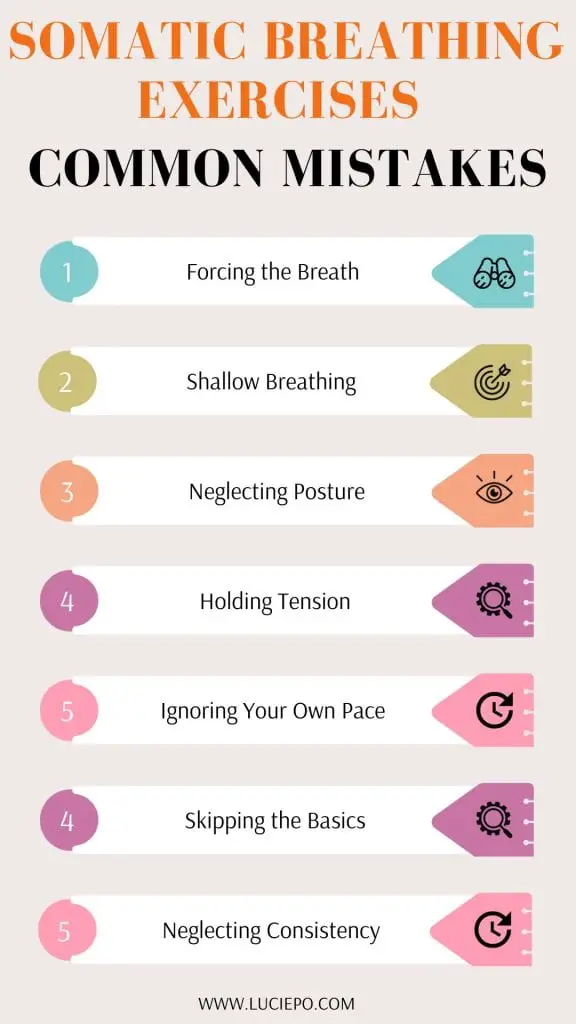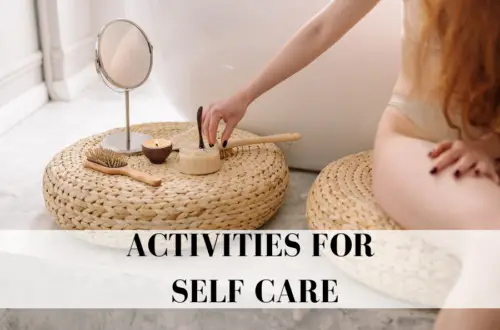
10 Powerful Somatic Breathing Exercises: Somatic Breathwork Training
Welcome to a journey of self-discovery and inner peace through the art of somatic breathing. In this blog post, we’re diving deep into the world of breathwork, exploring powerful techniques that have the potential to transform the way you approach stress, productivity, and overall well-being.
In the whirlwind of our fast-paced lives, finding a moment of genuine calm can seem like searching for a rare gem. That’s where somatic breathing exercises found their way into my routine, offering a serene oasis amidst the chaos. The impact? Well, it’s been pretty remarkable.
Picture this: a few intentional breaths, and suddenly, a wave of calm washes over, untangling the knots of stress and ushering in a fresh sense of peace. Productivity levels go through the roof, mental clarity sharpens, and a general feeling of well-being takes center stage.
Join me on this journey through somatic breathing, where art and science merge to create genuine positive change.
What are somatic breathing exercises?
Somatic breathing exercises are intentional techniques that focus on deep, mindful breathing. By engaging the diaphragm and expanding the abdomen, they optimize oxygen exchange and trigger the body’s relaxation response.
These exercises are a powerful tool for achieving physical, mental, and emotional balance.
Check out my blog post about 15 Stress Coping Strategies: Finding Your Inner Zen In Turbulent Times
The Science Behind Somatic Breathing
When you engage in intentional, deep breathing, you’re activating the parasympathetic nervous system. This is like the body’s built-in relaxation mode. It counteracts the stress response and helps you find a state of calm.
Deep, diaphragmatic breathing stimulates the vagus nerve, a major player in the relaxation response. This nerve connects your brain to various organs in your body, influencing heart rate, digestion, and even mood. When you activate the vagus nerve through somatic breathing, you’re essentially telling your body, “Hey, it’s time to chill out.” This leads to a lower heart rate, reduced blood pressure, and a sense of tranquility.
Somatic breathing also optimizes oxygen exchange in your lungs. When you take slow, deliberate breaths, you’re ensuring that your body receives the optimal amount of oxygen. This promotes better circulation, improves lung function, and boosts overall energy levels.
So, in a nutshell, somatic breathing is like a scientifically-backed shortcut to relaxation and well-being! It’s your body’s way of saying, “Thank you for taking care of me.” So go ahead, take a deep breath, and let the science do its magic!

Somatic Breathing Benefits
Embarking on the path of somatic breathing opens up a world of incredible benefits that go far beyond mere relaxation. It’s like discovering a personal oasis of calm in the midst of life’s whirlwind, offering a range of transformative advantages for both the body and mind.
- Stress Melter: Picture taking a few intentional breaths and feeling the world’s weight lift off your shoulders. Somatic breathing is your backstage pass to a stress-free zone.
- Productivity Powerhouse: After a session, I’m in a laser-focused, get-it-done mode. It’s like a secret productivity booster that keeps me in the zone.
- Your Inner Peace Sanctuary: With consistent practice, somatic breathing builds a fortress against stress, offering a wellspring of inner peace whenever you need it.
- Physical Harmony: Beyond relaxation, somatic breathing optimizes oxygen exchange, promoting better circulation and an energy boost. It’s like a mini spa day for your body.
- Mental Clarity Magic: Clarity sharpens, and creative juices flow after a bout of somatic breathing. It’s your shortcut to a clear, focused mind.
- Emotional Resilience: Somatic breathing is like a friend that helps you ride the waves of emotions. It provides a stable anchor in the midst of life’s ups and downs.
- Customized Wellness: Whether you’re dealing with stress, aiming for heightened focus, or seeking relaxation, somatic breathing is a versatile tool that adapts to your needs.
- Inner Strength Builder: It’s more than just a technique; it’s a journey of self-discovery, building resilience and inner strength with every breath.
- Your Daily Retreat: In the midst of a hectic day, somatic breathing offers a personal retreat, a moment of calm where you can recharge and reset.
- A Happier, Calmer You: Trust me, somatic breathing is your personal superpower for a happier, calmer you! It’s a gift you give yourself, and it keeps on giving.
If you want to learn more about somatic breathing I can definitely recommend a book called Minding the Body.
How to do somatic breathing?
- Find Your Cozy Spot: Choose a comfortable place where you can unwind. It could be your favorite chair, a peaceful corner, or a soft spot on the floor.
- Shut Out Distractions: Close your eyes if it helps you focus. Let this be a moment just for you.
- Dive into Your Breath: Visualize your breath starting deep in your belly. As you inhale, let your abdomen rise like a gentle wave. Feel that soothing expansion.
- Exhale and Release: With each exhale, imagine any tension or worries leaving your body. It’s like a mini-vacation for your soul.
- Body Check-In: Let your attention drift through your body. Notice any areas that might be holding onto tension – your shoulders, your jaw, your forehead. With each exhale, invite these areas to relax. It’s like a gentle massage from the inside.
- No Rush Zone: This is your sanctuary of calm, where time slows down. Let your breath flow at its own pace, embracing each inhale and exhale.
- Nurture the Connection: With every breath, you’re building a deeper bond with yourself. It’s like a warm hug for your soul.
- Open Your Eyes, Refreshed: When you’re ready, slowly open your eyes. Feel the calmness and carry it with you into your day.
If you want to practice mindfulness and meditation, I would definitely recommend a free app called Headspace. CHECK HERE.
How often to do breathing exercises?
Breathing exercises are like little gifts you give to yourself, and finding the right rhythm is all about tuning in to your own needs. It’s your personal journey, so there’s no right or wrong.
Let’s break it down:
- Listen to Your Body: Your body knows best. Pay attention to how you feel before and after a session. If you’re feeling more relaxed, centered, and refreshed, you’re on the right track!
- Quality Over Quantity: It’s not about the clock, it’s about the breath. Even a few minutes of mindful breathing can do wonders. So, don’t stress about the minutes.
- Consistency is Key: Just like a plant needs regular watering, aim for a daily session, even if it’s just for a handful of minutes. Little and often goes a long way.
- Blend It In: You don’t need a special space or time. Sneak in breathwork during daily activities like commuting, waiting in line, or even while doing chores. It’s like a mini wellness boost!
- Trust Your Instincts: There’s no one-size-fits-all. Some days, you might have more time for a longer session, and other days, a quick breathing break is perfect. Your body knows what it needs.
- Be Kind to Yourself: No rigid expectations, please. Some days are a bit more, and some are a bit less. It’s all part of the flow. Embrace the ebb and flow of life.
Free somatic exercises at home
Diaphragmatic Breathing
- Lie down or sit comfortably and place one hand on your chest and the other on your abdomen.
- Inhale deeply through your nose, allowing your abdomen to rise.
- Exhale slowly through your mouth, feeling your abdomen fall.
Box Breathing
- Inhale deeply for a count of five.
- Hold your breath for a count of five.
- Exhale slowly for a count of five.
- Hold your breath for a count of five.
- Repeat for several cycles.
Alternate Nostril Breathing (Nadi Shodhana Pranayama)
- Sit comfortably and close your right nostril with your right thumb.
- Inhale through your left nostril.
- Close your left nostril with your ring finger, and exhale through your right nostril.
- Continue this pattern, alternating sides.
Rib Cage Expansion Breath
- Sit or stand comfortably with a straight back.
- Place your hands on your rib cage, thumbs at the back, and fingers on the sides.
- Inhale slowly through your nose, focusing on expanding your rib cage outward.
- Exhale through your mouth, allowing your rib cage to gently contract.
- Continue this pattern, feeling the expansion and contraction with each breath.
Ocean Breath (Ujjayi Pranayama)
- Inhale deeply through your nose, slightly constricting the back of your throat to create an ocean-like sound.
- Exhale slowly through your nose, maintaining the constriction.
4-7-8 Breathing
- Inhale deeply for a count of four.
- Hold your breath for a count of seven.
- Exhale slowly for a count of eight.
- Repeat for several cycles.
Somatic Body Scan Breath
- Find a comfortable position, either sitting or lying down.
- Close your eyes and take a moment to relax your body.
- Start by taking a deep breath in through your nose, focusing on your feet.
- As you exhale, imagine any tension or stress in your feet melting away.
- Continue this process, moving up your body with each breath, releasing tension from your legs, torso, arms, and finally, your head.
- Once you’ve scanned your entire body, take a few moments to enjoy the sensation of relaxation before slowly opening your eyes.
Sighing Breath
- Take a deep, audible sighing breath in through your nose.
- Exhale slowly and audibly through your mouth.
Progressive Relaxation Breathing
- Inhale deeply and tense all the muscles in your body.
- Exhale and release all the tension, allowing your body to relax completely.
Resonant Breathing
- Inhale and exhale through your nose at a natural pace.
- As you do so, imagine your breath resonating in a specific area of your body, like your heart or your belly.
Incorporating Somatic Breathing into Your Daily Routine
Alright, let’s talk about how to weave these fantastic somatic breathing exercises into your day-to-day life. It’s simpler than you might think, and the benefits are totally worth it!
Start Your Day Right
Begin your morning with a few minutes of deep, intentional breathing. Whether you’re still in bed or sipping your morning brew, take a moment to center yourself with a few rounds of diaphragmatic breathing. It’ll set a positive tone for the day ahead.
Mini Breathing Breaks
Throughout your day, whenever you catch a moment, indulge in a mini breathing break. It could be during a work break, waiting for the kettle to boil, or even when you’re stuck in traffic. Close your eyes, take a few conscious breaths, and feel the tension melt away.
Sync with Daily Tasks
Turn mundane tasks into opportunities for mindful breathing. Whether you’re doing the dishes, standing in line, or waiting for an elevator, make it a habit to focus on your breath. It’s like a secret weapon against stress!
Wind Down in the Evening
As your day winds down, let your breathing follow suit. Engage in a calming exercise like the 4-7-8 technique or a gentle belly breathing visualization. It’ll help transition from the hustle and bustle to a state of relaxation.
Before Sleep Magic
Just before you hit the hay, indulge in some soothing breathwork. It could be a round of the Ocean Breath or a few rounds of Resonant Breathing. Trust me, it sets the stage for a restful night’s sleep.
Common Mistakes to Avoid
We’re all on this journey together, and it’s completely normal to stumble along the way. Here are some common missteps to keep an eye out for, so you can make the most out of your somatic breathing practice.
Forcing the Breath
Remember, this isn’t a race. Avoid the temptation to force your breath. Let it flow naturally, finding its own rhythm. Trust me, your body knows what it’s doing!
Shallow Breathing
It’s easy to slip into shallow breathing, especially when life gets a bit hectic. Take a moment to check in with yourself. Are you breathing from your chest or your abdomen? Aim for deep, diaphragmatic breaths for maximum benefit.
Neglecting Posture
Your posture matters! Slumping or hunching can restrict your breath. Whether you’re sitting or standing, maintain an open chest and relaxed shoulders. This allows for optimal airflow.
Holding Tension
Check in with your body. Are you holding onto tension in your jaw, shoulders, or elsewhere? Remember, somatic breathing is about release. Let go of any unnecessary strain.
Ignoring Your Own Pace
Each of us has our unique rhythm. Don’t worry about trying to match someone else’s breathing pattern. Listen to your body, and let it guide you.
Skipping the Basics
Even if you’re a seasoned pro, it’s always good to revisit the basics. Sometimes, in our eagerness to explore advanced techniques, we overlook the foundational exercises that form the core of somatic breathing.
Neglecting Consistency
Consistency is key! Like any practice, the more you do it, the more you’ll benefit. Even on busy days, squeeze in a few minutes of mindful breathing. It all adds up!
Frequently asked questions
Which breathing exercise is accompanied by arm movements?
The Alternate Nostril Breathing (Nadi Shodhana) technique is often accompanied by specific arm movements.
How often to do breathing exercises?
Aim for consistency. Even a few minutes of daily practice can yield significant benefits.
Why do breathing exercises work?
Breathing exercises activate the parasympathetic nervous system, promoting relaxation and reducing stress. They also optimize oxygen exchange, enhancing overall well-being.
Where is the somatic nervous system located?
The somatic nervous system is located in the peripheral nervous system and primarily controls voluntary muscle movements and sensory perception.
Are breathing exercises dangerous?
Generally, breathing exercises are safe for most individuals. However, it’s advisable to start slowly and consult a healthcare professional if you have specific health concerns.
How many breathing exercises per day?
Consistency matters more than quantity. Aim for at least one session per day, but feel free to practice more if time permits.
Breathing exercises vs. meditation
While both practices promote relaxation, breathing exercises specifically focus on breath control and can be a component of meditation. Meditation, on the other hand, encompasses a broader range of techniques to cultivate mindfulness and mental clarity.







